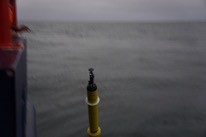Over the past week we made great progress in our journey of the sea, surveying an eddy off the west coast of Greenland with repeated ADCP and CTD surveys to investigate in detail the structure and content of these dynamic water features. We also deployed 2 more APEX floats in the centre of the eddy.
During the last few days while we finished the Labrador Sea part of our cruise and had our mid cruise celebration, I had the chance to sort out my thoughts and go through notes of conversations with more of the people on board. One thing I realized is that I never mentioned the amazing crew and captain of the Maria S. Merian. Without their patience, experience and watchful eye neither the mooring work, nor our CTD stations would have gone as smoothly as they did.
Besides doing a great job manoeuvring the vessel around always changing CTD station plans, the watch officers are always happy to have us come up to the bridge to say enjoy the sunset or answer questions about the many instruments on board. The watch officer during my CTD shift is 2nd officer Sandra Schilling and she has been on board the Merian for just under a year. I think it is amazing to see women in these leading roles and I am glad I got to meet Sandra on this cruise. I asked Sandra if she misses being on land, since 8 month of the year she spends at sea, but Sandra told me she feels happiest at sea and at the end of her time on land she always feels excited to be back on board for the next voyage. Apparently the coolest thing about her job is to navigate in unchartered waters. Pun intended!
As the current week is coming to an end near the Cape Farewell, Greenland I am also ready to describe more of the great group of people I share this cruise with. I like interdisciplinary nature of our cruise. One of the scientists from Canada, fresh from finishing her honors thesis is Ciara Willis. Ciara described to me a lifelong passion for marine biology that started at age 4 inspired by conservation issues in Nova Scotia. Ciara recently finished a degree in Marine Biology and Statistics in which she took part in projects in both Canada and the US and is now on this cruise sampling nutrients and vitamins from the CTD casts to investigate microbial activity in the sea as part of a research project at her University.
Ocean microbes are poorly understood and hard to cultivate in laboratories. Because microbes have such a fast lifecycle and are at the origin of the food chain for all other large aquatic species it is key to understand changes in their habitat to adapt better to climate change. One of the cool features of microbes such as phytoplankton is that they are a source of oxygen in the water through photosynthesis similar to plants. I think it is amazing to think that microbes in the ocean can behave like plants on the surface of the earth. Ciara’s hobbies at sea include bird watching and reading.
We are now closing in on the next and last part of our cruise which is to run CTD stations along Cape Farewell Greenland and then continue with the Eastern part of the OSNAP array, recovering moorings. The US research ship R/V Armstrong is also doing mooring recoveries in the vicinity and word has it we might even see each other in the coming days as a Rendevouz at Sea. Last December I already had the pleasure to visit this cool oceanographic research vessel and it will be exciting to see the ship in scientific action on the open seas!



